Report on Child Abuse, Bullying, Exploitation: Risks and Safeguarding
VerifiedAdded on 2023/01/12
|20
|5753
|2
Report
AI Summary
This report provides a detailed examination of child abuse, bullying, and exploitation, covering various aspects of child protection and safeguarding. It begins by defining abuse and outlining actions to be taken when abuse is suspected, emphasizing the importance of early identification and addressing reasons behind misinterpreted warning signs. The report then delves into different types of bullying, including physical, verbal, emotional, and cyberbullying, along with the policies and procedures for responding to bullying concerns and supporting affected children and young people. Further, the report addresses risks associated with social networking and internet use, and the actions to be taken when a child goes missing. It also explores child sexual exploitation, its relationship to human trafficking, patterns of exploitation, and support for victims, while highlighting the roles of key partners in protecting children. The report concludes by discussing multi-agency working, building self-confidence, developing protective strategies, empowering children, and the reporting of concerns, including whistleblowing protection and escalating concerns. The report aims to provide a thorough understanding of child protection issues and strategies to safeguard children and young adults.
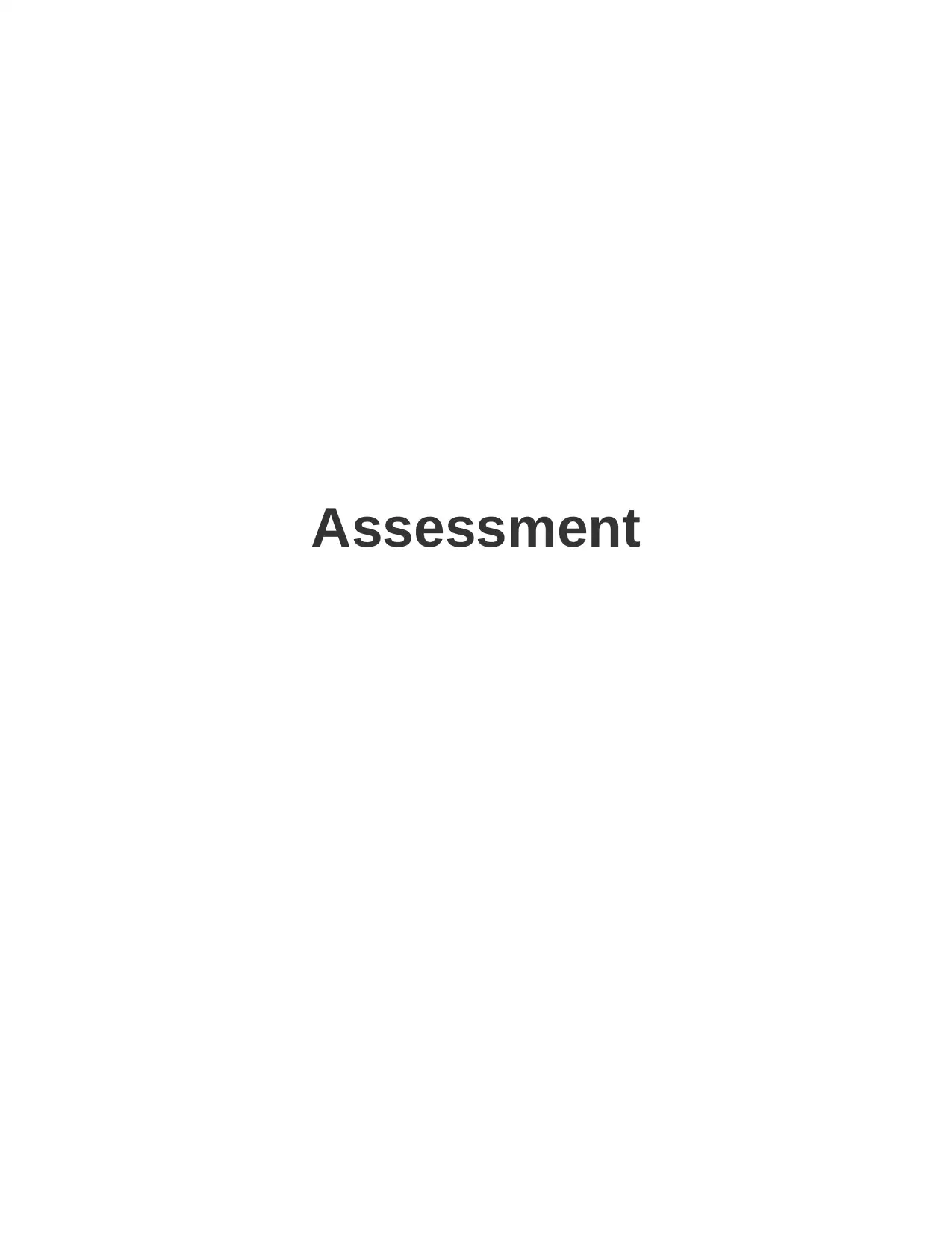
Assessment
Paraphrase This Document
Need a fresh take? Get an instant paraphrase of this document with our AI Paraphraser

Table of Contents
INTRODUCTION......................................................................................................................................4
LO4.............................................................................................................................................................4
4.1 Actions to be taken in case of abuse is suspected....................................................................4
4.2 Importance of early identification of abuse.................................................................................5
4.3 Reasons behind misinterpreted or ignored warning signs........................................................5
4.4 Reasons behind not identifying abuse........................................................................................6
LO5.............................................................................................................................................................6
5.1 Different types of bullying on children and young people.........................................................6
5.2 Policies and procedures in response to concern of bullying....................................................7
5.3 Importance of policies and procedures of bullying.....................................................................7
5.4 Ways to support children’s and young person to face with bullying........................................8
LO6.............................................................................................................................................................9
6.1 Risk and possible consequences.................................................................................................9
6.2 Ways to reduce risk.......................................................................................................................9
LO7...........................................................................................................................................................10
7.1 Risk of children and young age people missing from care.....................................................10
7.2 Actions for child or young adults who get missing...................................................................10
7.3 Importance of actions in case of missing children’s and young adults.................................10
LO 8..........................................................................................................................................................10
8.1 Child sexual exploitation and its relationship to human trafficking........................................10
8.2Child sexual exploitation differs from non-abusive sexual activity..........................................11
8.3 Different patterns of child sexual exploitation...........................................................................11
8. 4 Typical behaviour patterns of those who sexually exploit children and young people.......12
8.5 Describe the support which offer to a child or young person who has been the victim of
child sexual exploitation.....................................................................................................................13
8.6 Role of key partners in protecting children and young people from sexual exploitation.....13
LO 9..........................................................................................................................................................15
9.1 Multi Agency Working..................................................................................................................15
9.2 Multi Agency Forums...................................................................................................................15
9.3 Roles and Responsibilities of Organisations in Different Scenarios......................................15
LO 10........................................................................................................................................................16
INTRODUCTION......................................................................................................................................4
LO4.............................................................................................................................................................4
4.1 Actions to be taken in case of abuse is suspected....................................................................4
4.2 Importance of early identification of abuse.................................................................................5
4.3 Reasons behind misinterpreted or ignored warning signs........................................................5
4.4 Reasons behind not identifying abuse........................................................................................6
LO5.............................................................................................................................................................6
5.1 Different types of bullying on children and young people.........................................................6
5.2 Policies and procedures in response to concern of bullying....................................................7
5.3 Importance of policies and procedures of bullying.....................................................................7
5.4 Ways to support children’s and young person to face with bullying........................................8
LO6.............................................................................................................................................................9
6.1 Risk and possible consequences.................................................................................................9
6.2 Ways to reduce risk.......................................................................................................................9
LO7...........................................................................................................................................................10
7.1 Risk of children and young age people missing from care.....................................................10
7.2 Actions for child or young adults who get missing...................................................................10
7.3 Importance of actions in case of missing children’s and young adults.................................10
LO 8..........................................................................................................................................................10
8.1 Child sexual exploitation and its relationship to human trafficking........................................10
8.2Child sexual exploitation differs from non-abusive sexual activity..........................................11
8.3 Different patterns of child sexual exploitation...........................................................................11
8. 4 Typical behaviour patterns of those who sexually exploit children and young people.......12
8.5 Describe the support which offer to a child or young person who has been the victim of
child sexual exploitation.....................................................................................................................13
8.6 Role of key partners in protecting children and young people from sexual exploitation.....13
LO 9..........................................................................................................................................................15
9.1 Multi Agency Working..................................................................................................................15
9.2 Multi Agency Forums...................................................................................................................15
9.3 Roles and Responsibilities of Organisations in Different Scenarios......................................15
LO 10........................................................................................................................................................16
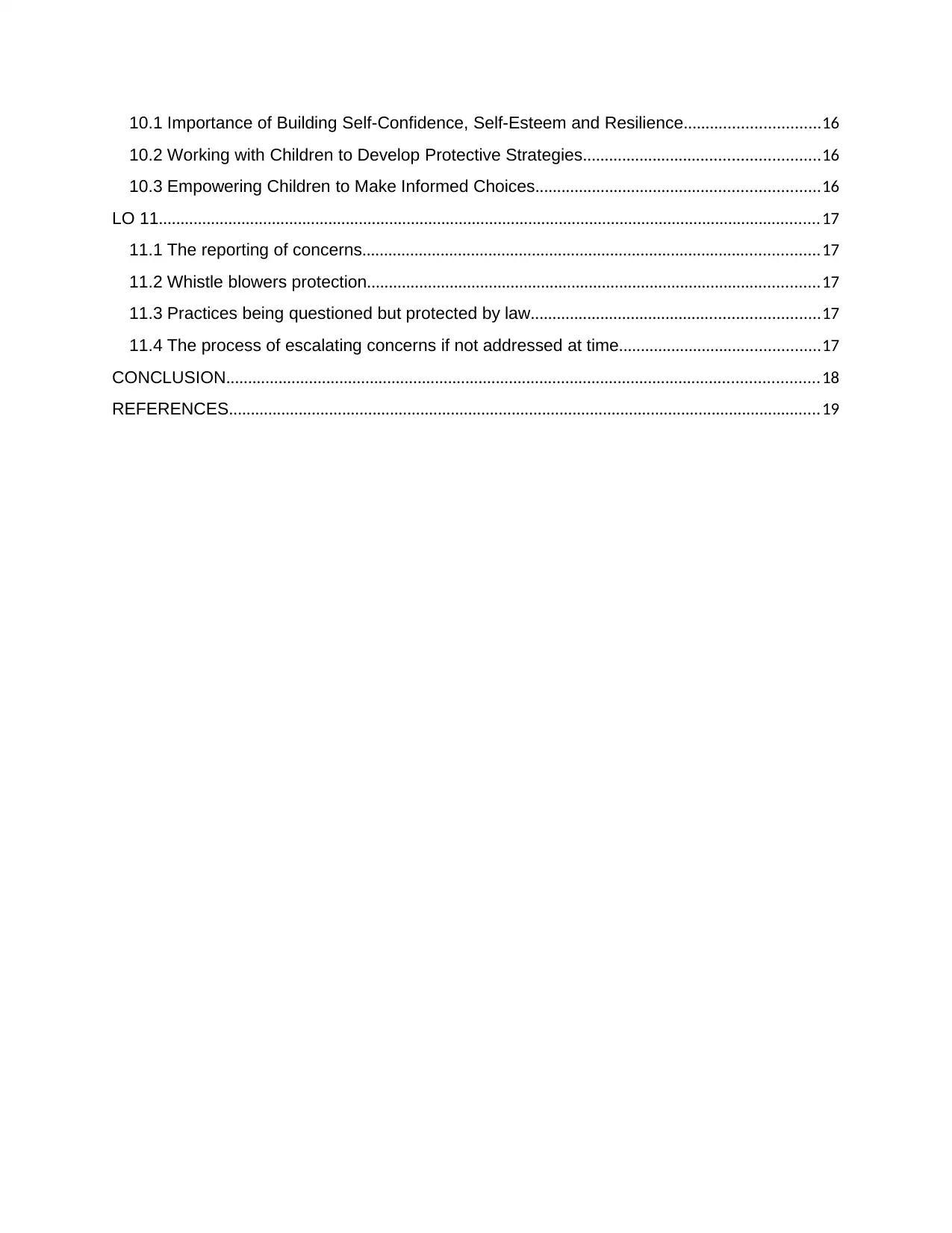
10.1 Importance of Building Self-Confidence, Self-Esteem and Resilience...............................16
10.2 Working with Children to Develop Protective Strategies......................................................16
10.3 Empowering Children to Make Informed Choices.................................................................16
LO 11........................................................................................................................................................17
11.1 The reporting of concerns.........................................................................................................17
11.2 Whistle blowers protection........................................................................................................17
11.3 Practices being questioned but protected by law..................................................................17
11.4 The process of escalating concerns if not addressed at time..............................................17
CONCLUSION........................................................................................................................................18
REFERENCES........................................................................................................................................19
10.2 Working with Children to Develop Protective Strategies......................................................16
10.3 Empowering Children to Make Informed Choices.................................................................16
LO 11........................................................................................................................................................17
11.1 The reporting of concerns.........................................................................................................17
11.2 Whistle blowers protection........................................................................................................17
11.3 Practices being questioned but protected by law..................................................................17
11.4 The process of escalating concerns if not addressed at time..............................................17
CONCLUSION........................................................................................................................................18
REFERENCES........................................................................................................................................19
⊘ This is a preview!⊘
Do you want full access?
Subscribe today to unlock all pages.

Trusted by 1+ million students worldwide
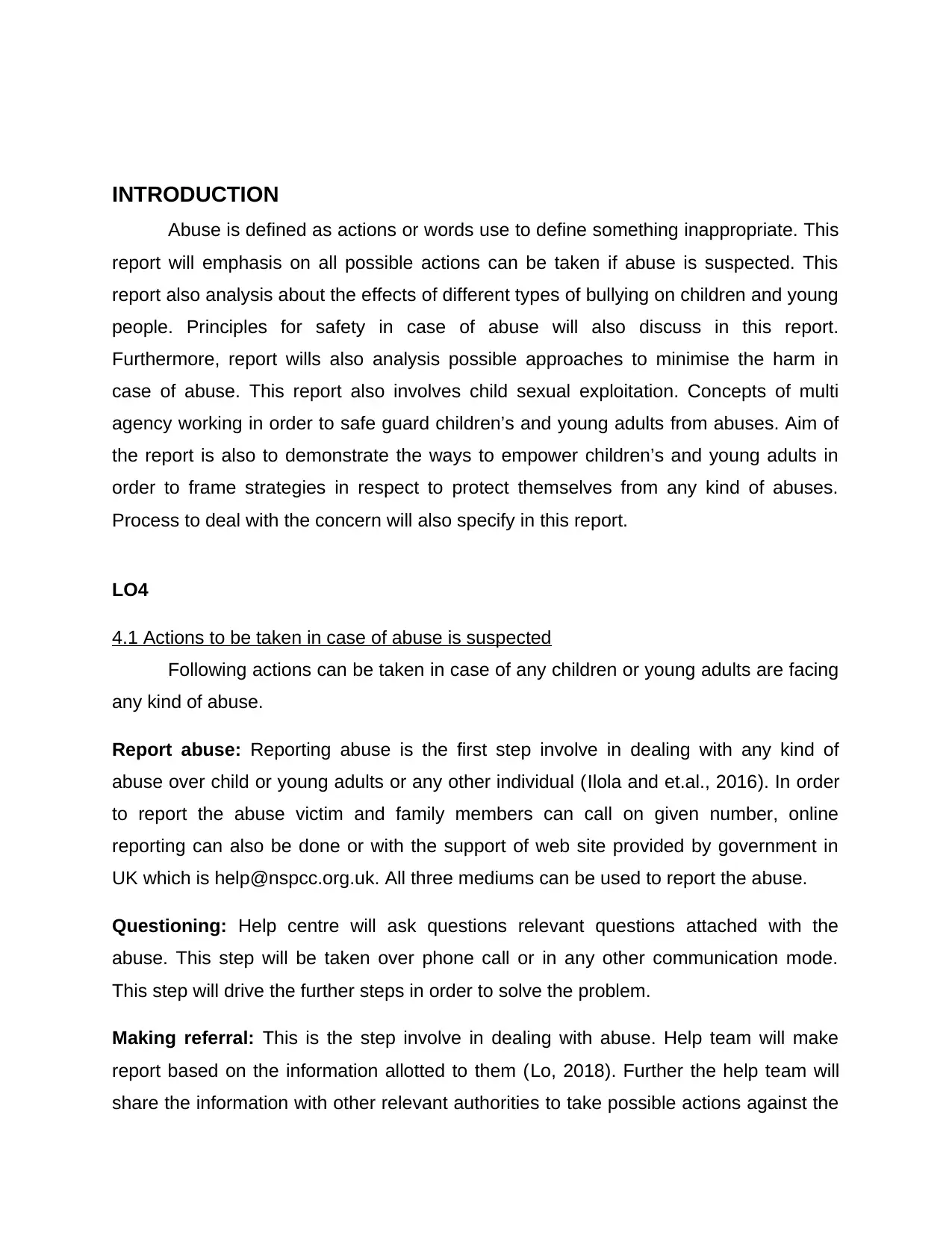
INTRODUCTION
Abuse is defined as actions or words use to define something inappropriate. This
report will emphasis on all possible actions can be taken if abuse is suspected. This
report also analysis about the effects of different types of bullying on children and young
people. Principles for safety in case of abuse will also discuss in this report.
Furthermore, report wills also analysis possible approaches to minimise the harm in
case of abuse. This report also involves child sexual exploitation. Concepts of multi
agency working in order to safe guard children’s and young adults from abuses. Aim of
the report is also to demonstrate the ways to empower children’s and young adults in
order to frame strategies in respect to protect themselves from any kind of abuses.
Process to deal with the concern will also specify in this report.
LO4
4.1 Actions to be taken in case of abuse is suspected
Following actions can be taken in case of any children or young adults are facing
any kind of abuse.
Report abuse: Reporting abuse is the first step involve in dealing with any kind of
abuse over child or young adults or any other individual (Ilola and et.al., 2016). In order
to report the abuse victim and family members can call on given number, online
reporting can also be done or with the support of web site provided by government in
UK which is help@nspcc.org.uk. All three mediums can be used to report the abuse.
Questioning: Help centre will ask questions relevant questions attached with the
abuse. This step will be taken over phone call or in any other communication mode.
This step will drive the further steps in order to solve the problem.
Making referral: This is the step involve in dealing with abuse. Help team will make
report based on the information allotted to them (Lo, 2018). Further the help team will
share the information with other relevant authorities to take possible actions against the
Abuse is defined as actions or words use to define something inappropriate. This
report will emphasis on all possible actions can be taken if abuse is suspected. This
report also analysis about the effects of different types of bullying on children and young
people. Principles for safety in case of abuse will also discuss in this report.
Furthermore, report wills also analysis possible approaches to minimise the harm in
case of abuse. This report also involves child sexual exploitation. Concepts of multi
agency working in order to safe guard children’s and young adults from abuses. Aim of
the report is also to demonstrate the ways to empower children’s and young adults in
order to frame strategies in respect to protect themselves from any kind of abuses.
Process to deal with the concern will also specify in this report.
LO4
4.1 Actions to be taken in case of abuse is suspected
Following actions can be taken in case of any children or young adults are facing
any kind of abuse.
Report abuse: Reporting abuse is the first step involve in dealing with any kind of
abuse over child or young adults or any other individual (Ilola and et.al., 2016). In order
to report the abuse victim and family members can call on given number, online
reporting can also be done or with the support of web site provided by government in
UK which is help@nspcc.org.uk. All three mediums can be used to report the abuse.
Questioning: Help centre will ask questions relevant questions attached with the
abuse. This step will be taken over phone call or in any other communication mode.
This step will drive the further steps in order to solve the problem.
Making referral: This is the step involve in dealing with abuse. Help team will make
report based on the information allotted to them (Lo, 2018). Further the help team will
share the information with other relevant authorities to take possible actions against the
Paraphrase This Document
Need a fresh take? Get an instant paraphrase of this document with our AI Paraphraser

child and young adult abuse. Help centre will also call to police station in case of victim
is facing immediate danger.
Further actions: The authorised body take possible actions in against to deal with child
abuse. On the basis of case reported and information provided by victim further actions
such as courts case and other actions will take.
All the steps are taken to deal with the abuse.
4.2 Importance of early identification of abuse
Importance of early identification can be summarised in the following manner.
Protect from harm: Early identification of abuse prevent children’s and young adults
from any kind of harm. In majority of cases due to abuse children’s and adults face
couple of harm at both physical as well mental levels. Early identification of abuse will
ensure prevention frm all kinds of harm.
Reduces need of referral for child protection: Early identification will also causes to
reduce referrals for the protection of children and young adults (Suzuki and et.al., 2017).
Identification at early stages will guide parents to take better actions in order to deal with
the situation.
Improve child long term outcomes: Early identification of child abuse will also
improve the long term outcomes of children’s. Abuse creates negative impacts on the
mental stability of children and young adults which also harms the future of such
children and adults. This will also help in improving the long term outcome of children.
All the aspects indicate about the importance of early identification of abuse.
4.3 Reasons behind misinterpreted or ignored warning signs
Most of times parents and guardians do not give emphasis on the warning signs
conveyed by children’s and young adults in respect to abuse (Karagiannis and et.al.,
2017). Due to busy schedule and casual approach of parents they do not give focus on
the signs. Many times children’s and young adult do not communicate properly which
is facing immediate danger.
Further actions: The authorised body take possible actions in against to deal with child
abuse. On the basis of case reported and information provided by victim further actions
such as courts case and other actions will take.
All the steps are taken to deal with the abuse.
4.2 Importance of early identification of abuse
Importance of early identification can be summarised in the following manner.
Protect from harm: Early identification of abuse prevent children’s and young adults
from any kind of harm. In majority of cases due to abuse children’s and adults face
couple of harm at both physical as well mental levels. Early identification of abuse will
ensure prevention frm all kinds of harm.
Reduces need of referral for child protection: Early identification will also causes to
reduce referrals for the protection of children and young adults (Suzuki and et.al., 2017).
Identification at early stages will guide parents to take better actions in order to deal with
the situation.
Improve child long term outcomes: Early identification of child abuse will also
improve the long term outcomes of children’s. Abuse creates negative impacts on the
mental stability of children and young adults which also harms the future of such
children and adults. This will also help in improving the long term outcome of children.
All the aspects indicate about the importance of early identification of abuse.
4.3 Reasons behind misinterpreted or ignored warning signs
Most of times parents and guardians do not give emphasis on the warning signs
conveyed by children’s and young adults in respect to abuse (Karagiannis and et.al.,
2017). Due to busy schedule and casual approach of parents they do not give focus on
the signs. Many times children’s and young adult do not communicate properly which

also causes to ignore signs of abuse. Communication gap is also the big reason behind
the misinterpreted or ignored warning sign.
4.4 Reasons behind not identifying abuse
Among all challenges to identify the abuse is also the key challenge victim face.
Most of the times children’s and young adults do not realise that they are facing any
kind of abuse due to casual behaviour. Children’s do not identify due to young or small
age which allows them to think about only playing games (Banday and et.al., 2018).
Young adults also do not give mush emphasis on abuses in case the abuse is
associated to verbal abuse. If the abuse is not initiated in form of any physical action
then it becomes difficult for the victims to identify the abuse. Most of the times victims
also do not catch the possible signs of abuse which also causes to unidentified abuse.
Physical abuse can be easily recognised as victim get to experience it clearly but due to
young age and social values most of the times victims do not realise that any kind of
verbal abuse is happening with them.
LO5
5.1 Different types of bullying on children and young people
Based on the nature bullying can be summarised into following kinds.
Physical: Physical bullying involves using physical farce to bully children and young
adults. This is among the most common way to bully an individual. It involves pushing,
hitting, pinching and some kind of violence with the use of physical force.
Verbal: Verbal bullying is also among the primary activity involved in bullying children’s
and young adults. It involves name calling, insults, sarcasm, spreading rumours and
persistently irritate someone (Georgiou, Ioannou and Stavrinides, 2017). This bullying
does not involve physical force but this is more like verbal in nature. It does not involve
any kind of physical force or power to bully children or young adults.
Emotional: Emotional bullying is also an effective way technique to bully children’s and
young adults. This involves tormenting, ridicule, humiliation and other kinds of emotional
the misinterpreted or ignored warning sign.
4.4 Reasons behind not identifying abuse
Among all challenges to identify the abuse is also the key challenge victim face.
Most of the times children’s and young adults do not realise that they are facing any
kind of abuse due to casual behaviour. Children’s do not identify due to young or small
age which allows them to think about only playing games (Banday and et.al., 2018).
Young adults also do not give mush emphasis on abuses in case the abuse is
associated to verbal abuse. If the abuse is not initiated in form of any physical action
then it becomes difficult for the victims to identify the abuse. Most of the times victims
also do not catch the possible signs of abuse which also causes to unidentified abuse.
Physical abuse can be easily recognised as victim get to experience it clearly but due to
young age and social values most of the times victims do not realise that any kind of
verbal abuse is happening with them.
LO5
5.1 Different types of bullying on children and young people
Based on the nature bullying can be summarised into following kinds.
Physical: Physical bullying involves using physical farce to bully children and young
adults. This is among the most common way to bully an individual. It involves pushing,
hitting, pinching and some kind of violence with the use of physical force.
Verbal: Verbal bullying is also among the primary activity involved in bullying children’s
and young adults. It involves name calling, insults, sarcasm, spreading rumours and
persistently irritate someone (Georgiou, Ioannou and Stavrinides, 2017). This bullying
does not involve physical force but this is more like verbal in nature. It does not involve
any kind of physical force or power to bully children or young adults.
Emotional: Emotional bullying is also an effective way technique to bully children’s and
young adults. This involves tormenting, ridicule, humiliation and other kinds of emotional
⊘ This is a preview!⊘
Do you want full access?
Subscribe today to unlock all pages.

Trusted by 1+ million students worldwide

tortures. This involves hitting someone’s emotional presence of mind to bully. This is
among the common approach to bully children’s and young adults.
Cyber bullying: Cyber bullying is consisted as the latest technique to bully children’s
and young adults. This technique involve using of information technology such as social
media, internet, mobile phones and other devices like computers to bully children’s and
young adults. This technique involves sending inappropriate texts. This is the latest
technique to bully children’s and young adults.
Others: Apart from all the above methods and techniques to bully children’s and young
adult there are other techniques as well. Such bullying kinds involve gender based
bullying, racism, disabilities based and other kinds of bullying. This is also consisted as
among the common approach to bully children and young adults. Bullying also involves
child to child bullying, child to adults bullying or adult to child bullying.
All the above points specifies about different kinds of bullying on children’s and
young adults.
5.2 Policies and procedures in response to concern of bullying
In case of any children’s or young adults is facing any kind sof bullying activity
then it can be reported over the given number provided by government or over the
website. Suitable actions will be taken to get rid from the bullying activity for victim
(Turns and Sibley, 2018). Children’s or young adults can convey to the parents and
guardians about the bullying activity they are facing. Government has recommended
suitable actions to deal effectively with the bullying. After the bullying is reported to the
authorised dignitaries’ further actions will be taken by them. Victims only need to report
the bullying.
5.3 Importance of policies and procedures of bullying
Procedure of dealing with bullying gives following importance that can be
summarised in the following manner.
Support in controlling bullying: Procedure of dealing with bullying activity supports
children’s and young adults to deal with the bullying. This will lead them to face the
among the common approach to bully children’s and young adults.
Cyber bullying: Cyber bullying is consisted as the latest technique to bully children’s
and young adults. This technique involve using of information technology such as social
media, internet, mobile phones and other devices like computers to bully children’s and
young adults. This technique involves sending inappropriate texts. This is the latest
technique to bully children’s and young adults.
Others: Apart from all the above methods and techniques to bully children’s and young
adult there are other techniques as well. Such bullying kinds involve gender based
bullying, racism, disabilities based and other kinds of bullying. This is also consisted as
among the common approach to bully children and young adults. Bullying also involves
child to child bullying, child to adults bullying or adult to child bullying.
All the above points specifies about different kinds of bullying on children’s and
young adults.
5.2 Policies and procedures in response to concern of bullying
In case of any children’s or young adults is facing any kind sof bullying activity
then it can be reported over the given number provided by government or over the
website. Suitable actions will be taken to get rid from the bullying activity for victim
(Turns and Sibley, 2018). Children’s or young adults can convey to the parents and
guardians about the bullying activity they are facing. Government has recommended
suitable actions to deal effectively with the bullying. After the bullying is reported to the
authorised dignitaries’ further actions will be taken by them. Victims only need to report
the bullying.
5.3 Importance of policies and procedures of bullying
Procedure of dealing with bullying gives following importance that can be
summarised in the following manner.
Support in controlling bullying: Procedure of dealing with bullying activity supports
children’s and young adults to deal with the bullying. This will lead them to face the
Paraphrase This Document
Need a fresh take? Get an instant paraphrase of this document with our AI Paraphraser
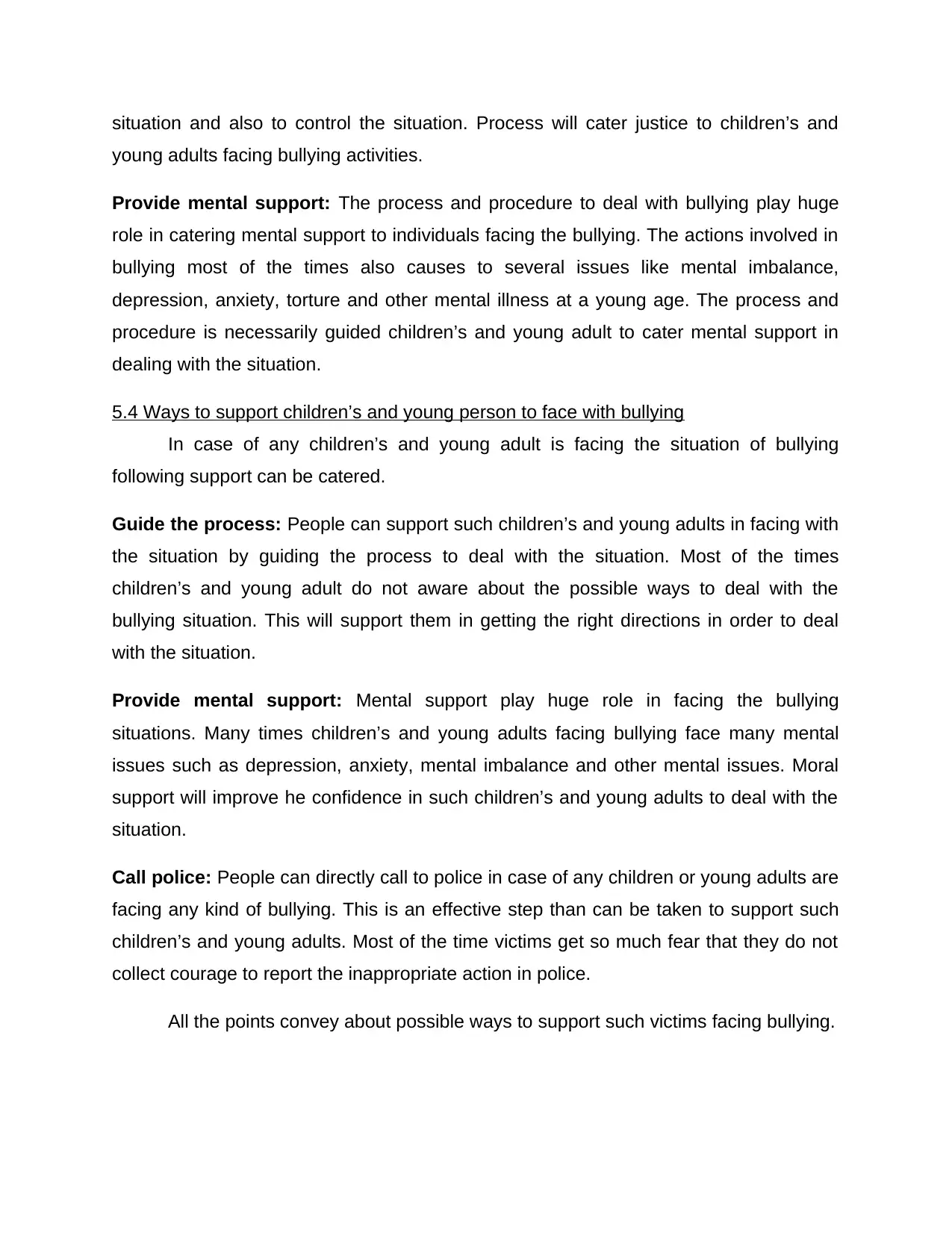
situation and also to control the situation. Process will cater justice to children’s and
young adults facing bullying activities.
Provide mental support: The process and procedure to deal with bullying play huge
role in catering mental support to individuals facing the bullying. The actions involved in
bullying most of the times also causes to several issues like mental imbalance,
depression, anxiety, torture and other mental illness at a young age. The process and
procedure is necessarily guided children’s and young adult to cater mental support in
dealing with the situation.
5.4 Ways to support children’s and young person to face with bullying
In case of any children’s and young adult is facing the situation of bullying
following support can be catered.
Guide the process: People can support such children’s and young adults in facing with
the situation by guiding the process to deal with the situation. Most of the times
children’s and young adult do not aware about the possible ways to deal with the
bullying situation. This will support them in getting the right directions in order to deal
with the situation.
Provide mental support: Mental support play huge role in facing the bullying
situations. Many times children’s and young adults facing bullying face many mental
issues such as depression, anxiety, mental imbalance and other mental issues. Moral
support will improve he confidence in such children’s and young adults to deal with the
situation.
Call police: People can directly call to police in case of any children or young adults are
facing any kind of bullying. This is an effective step than can be taken to support such
children’s and young adults. Most of the time victims get so much fear that they do not
collect courage to report the inappropriate action in police.
All the points convey about possible ways to support such victims facing bullying.
young adults facing bullying activities.
Provide mental support: The process and procedure to deal with bullying play huge
role in catering mental support to individuals facing the bullying. The actions involved in
bullying most of the times also causes to several issues like mental imbalance,
depression, anxiety, torture and other mental illness at a young age. The process and
procedure is necessarily guided children’s and young adult to cater mental support in
dealing with the situation.
5.4 Ways to support children’s and young person to face with bullying
In case of any children’s and young adult is facing the situation of bullying
following support can be catered.
Guide the process: People can support such children’s and young adults in facing with
the situation by guiding the process to deal with the situation. Most of the times
children’s and young adult do not aware about the possible ways to deal with the
bullying situation. This will support them in getting the right directions in order to deal
with the situation.
Provide mental support: Mental support play huge role in facing the bullying
situations. Many times children’s and young adults facing bullying face many mental
issues such as depression, anxiety, mental imbalance and other mental issues. Moral
support will improve he confidence in such children’s and young adults to deal with the
situation.
Call police: People can directly call to police in case of any children or young adults are
facing any kind of bullying. This is an effective step than can be taken to support such
children’s and young adults. Most of the time victims get so much fear that they do not
collect courage to report the inappropriate action in police.
All the points convey about possible ways to support such victims facing bullying.

LO6
6.1 Risk and possible consequences
Risk and possible consequence can be summarised in the following manner.
Social networking: Social networking is a very risky platform children and young
adult’s consists. Social media network consist up with plenty of personal information
about the users. As the social media application consisted with plenty of personal
information related to users many times information of users gets leakage.
Internet use: Internet consumers plenty of time personal information about the users.
Due to latest technology internet also reveal about the location of users. This can also
causes to inappropriate use of the personal information of the users. People also face
fraud and unethical misconduct due to that.
Buying and selling online: Websites involves in buying and selling face most of the
time issues related to leakage of users information (Ang and et.al., 2018). Information
play crucial role and in case of leakage of such information people face issues like
bullying or frauds or other relative issues.
Electronic communication devices: Electronic communication devices are used to
share information with other individuals. This can also causes to leakage of user’s
information with the help of hacking of devices.
6.2 Ways to reduce risk
Social networking: Social media is a huge medium to improve the connectivity. Users
can ensure the safety over social media by storing only limited personal information
over such devices.
Internet use: Internet has becomes a crucial part of the daily lifestyle. Children’s and
young adults can improve the safety over internet by not sharing irrelevant personal
information.
Buying and selling online: In order to consult buying and selling children’s and young
adults can ensure safety by sharing only limited information.
6.1 Risk and possible consequences
Risk and possible consequence can be summarised in the following manner.
Social networking: Social networking is a very risky platform children and young
adult’s consists. Social media network consist up with plenty of personal information
about the users. As the social media application consisted with plenty of personal
information related to users many times information of users gets leakage.
Internet use: Internet consumers plenty of time personal information about the users.
Due to latest technology internet also reveal about the location of users. This can also
causes to inappropriate use of the personal information of the users. People also face
fraud and unethical misconduct due to that.
Buying and selling online: Websites involves in buying and selling face most of the
time issues related to leakage of users information (Ang and et.al., 2018). Information
play crucial role and in case of leakage of such information people face issues like
bullying or frauds or other relative issues.
Electronic communication devices: Electronic communication devices are used to
share information with other individuals. This can also causes to leakage of user’s
information with the help of hacking of devices.
6.2 Ways to reduce risk
Social networking: Social media is a huge medium to improve the connectivity. Users
can ensure the safety over social media by storing only limited personal information
over such devices.
Internet use: Internet has becomes a crucial part of the daily lifestyle. Children’s and
young adults can improve the safety over internet by not sharing irrelevant personal
information.
Buying and selling online: In order to consult buying and selling children’s and young
adults can ensure safety by sharing only limited information.
⊘ This is a preview!⊘
Do you want full access?
Subscribe today to unlock all pages.

Trusted by 1+ million students worldwide
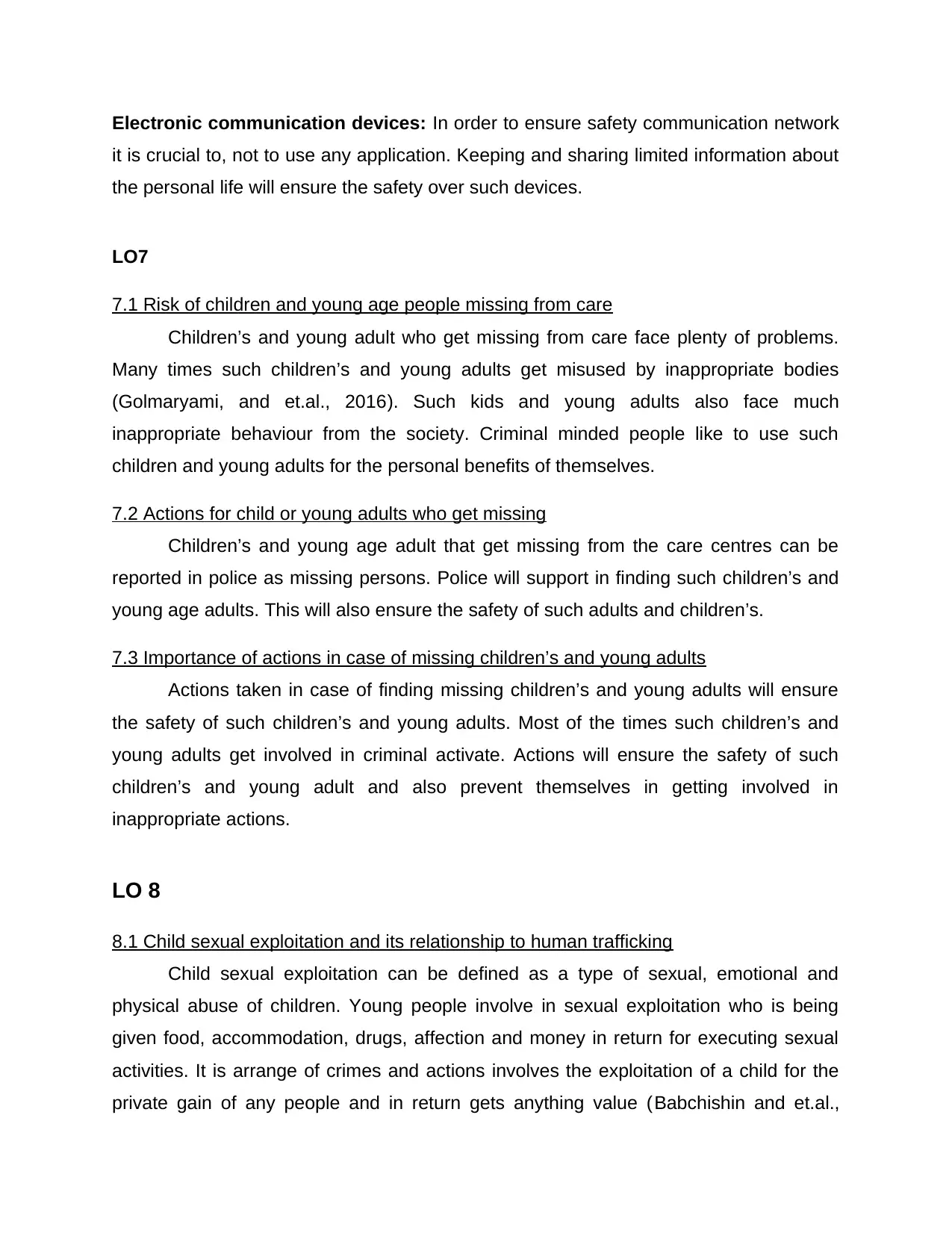
Electronic communication devices: In order to ensure safety communication network
it is crucial to, not to use any application. Keeping and sharing limited information about
the personal life will ensure the safety over such devices.
LO7
7.1 Risk of children and young age people missing from care
Children’s and young adult who get missing from care face plenty of problems.
Many times such children’s and young adults get misused by inappropriate bodies
(Golmaryami, and et.al., 2016). Such kids and young adults also face much
inappropriate behaviour from the society. Criminal minded people like to use such
children and young adults for the personal benefits of themselves.
7.2 Actions for child or young adults who get missing
Children’s and young age adult that get missing from the care centres can be
reported in police as missing persons. Police will support in finding such children’s and
young age adults. This will also ensure the safety of such adults and children’s.
7.3 Importance of actions in case of missing children’s and young adults
Actions taken in case of finding missing children’s and young adults will ensure
the safety of such children’s and young adults. Most of the times such children’s and
young adults get involved in criminal activate. Actions will ensure the safety of such
children’s and young adult and also prevent themselves in getting involved in
inappropriate actions.
LO 8
8.1 Child sexual exploitation and its relationship to human trafficking
Child sexual exploitation can be defined as a type of sexual, emotional and
physical abuse of children. Young people involve in sexual exploitation who is being
given food, accommodation, drugs, affection and money in return for executing sexual
activities. It is arrange of crimes and actions involves the exploitation of a child for the
private gain of any people and in return gets anything value (Babchishin and et.al.,
it is crucial to, not to use any application. Keeping and sharing limited information about
the personal life will ensure the safety over such devices.
LO7
7.1 Risk of children and young age people missing from care
Children’s and young adult who get missing from care face plenty of problems.
Many times such children’s and young adults get misused by inappropriate bodies
(Golmaryami, and et.al., 2016). Such kids and young adults also face much
inappropriate behaviour from the society. Criminal minded people like to use such
children and young adults for the personal benefits of themselves.
7.2 Actions for child or young adults who get missing
Children’s and young age adult that get missing from the care centres can be
reported in police as missing persons. Police will support in finding such children’s and
young age adults. This will also ensure the safety of such adults and children’s.
7.3 Importance of actions in case of missing children’s and young adults
Actions taken in case of finding missing children’s and young adults will ensure
the safety of such children’s and young adults. Most of the times such children’s and
young adults get involved in criminal activate. Actions will ensure the safety of such
children’s and young adult and also prevent themselves in getting involved in
inappropriate actions.
LO 8
8.1 Child sexual exploitation and its relationship to human trafficking
Child sexual exploitation can be defined as a type of sexual, emotional and
physical abuse of children. Young people involve in sexual exploitation who is being
given food, accommodation, drugs, affection and money in return for executing sexual
activities. It is arrange of crimes and actions involves the exploitation of a child for the
private gain of any people and in return gets anything value (Babchishin and et.al.,
Paraphrase This Document
Need a fresh take? Get an instant paraphrase of this document with our AI Paraphraser
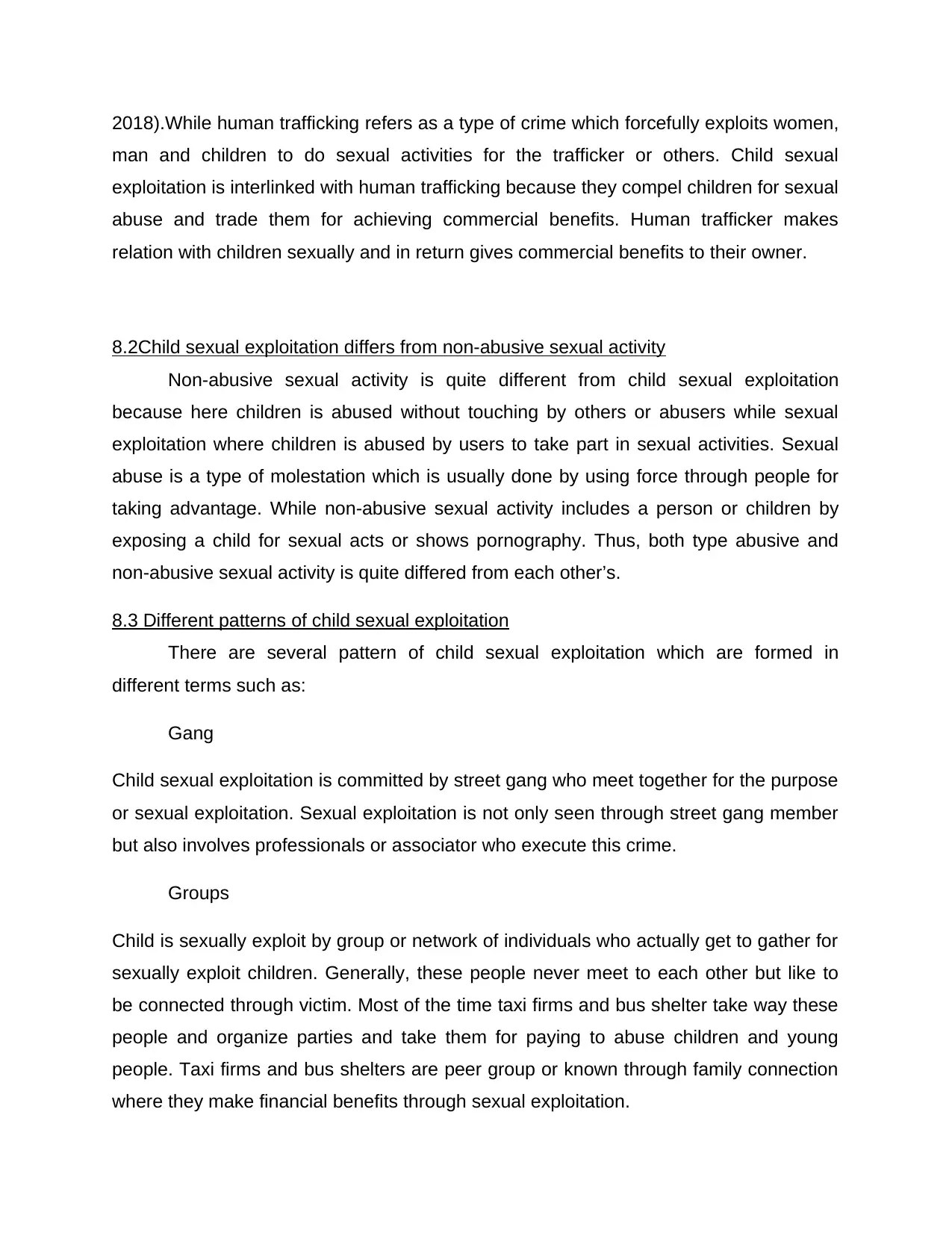
2018).While human trafficking refers as a type of crime which forcefully exploits women,
man and children to do sexual activities for the trafficker or others. Child sexual
exploitation is interlinked with human trafficking because they compel children for sexual
abuse and trade them for achieving commercial benefits. Human trafficker makes
relation with children sexually and in return gives commercial benefits to their owner.
8.2Child sexual exploitation differs from non-abusive sexual activity
Non-abusive sexual activity is quite different from child sexual exploitation
because here children is abused without touching by others or abusers while sexual
exploitation where children is abused by users to take part in sexual activities. Sexual
abuse is a type of molestation which is usually done by using force through people for
taking advantage. While non-abusive sexual activity includes a person or children by
exposing a child for sexual acts or shows pornography. Thus, both type abusive and
non-abusive sexual activity is quite differed from each other’s.
8.3 Different patterns of child sexual exploitation
There are several pattern of child sexual exploitation which are formed in
different terms such as:
Gang
Child sexual exploitation is committed by street gang who meet together for the purpose
or sexual exploitation. Sexual exploitation is not only seen through street gang member
but also involves professionals or associator who execute this crime.
Groups
Child is sexually exploit by group or network of individuals who actually get to gather for
sexually exploit children. Generally, these people never meet to each other but like to
be connected through victim. Most of the time taxi firms and bus shelter take way these
people and organize parties and take them for paying to abuse children and young
people. Taxi firms and bus shelters are peer group or known through family connection
where they make financial benefits through sexual exploitation.
man and children to do sexual activities for the trafficker or others. Child sexual
exploitation is interlinked with human trafficking because they compel children for sexual
abuse and trade them for achieving commercial benefits. Human trafficker makes
relation with children sexually and in return gives commercial benefits to their owner.
8.2Child sexual exploitation differs from non-abusive sexual activity
Non-abusive sexual activity is quite different from child sexual exploitation
because here children is abused without touching by others or abusers while sexual
exploitation where children is abused by users to take part in sexual activities. Sexual
abuse is a type of molestation which is usually done by using force through people for
taking advantage. While non-abusive sexual activity includes a person or children by
exposing a child for sexual acts or shows pornography. Thus, both type abusive and
non-abusive sexual activity is quite differed from each other’s.
8.3 Different patterns of child sexual exploitation
There are several pattern of child sexual exploitation which are formed in
different terms such as:
Gang
Child sexual exploitation is committed by street gang who meet together for the purpose
or sexual exploitation. Sexual exploitation is not only seen through street gang member
but also involves professionals or associator who execute this crime.
Groups
Child is sexually exploit by group or network of individuals who actually get to gather for
sexually exploit children. Generally, these people never meet to each other but like to
be connected through victim. Most of the time taxi firms and bus shelter take way these
people and organize parties and take them for paying to abuse children and young
people. Taxi firms and bus shelters are peer group or known through family connection
where they make financial benefits through sexual exploitation.
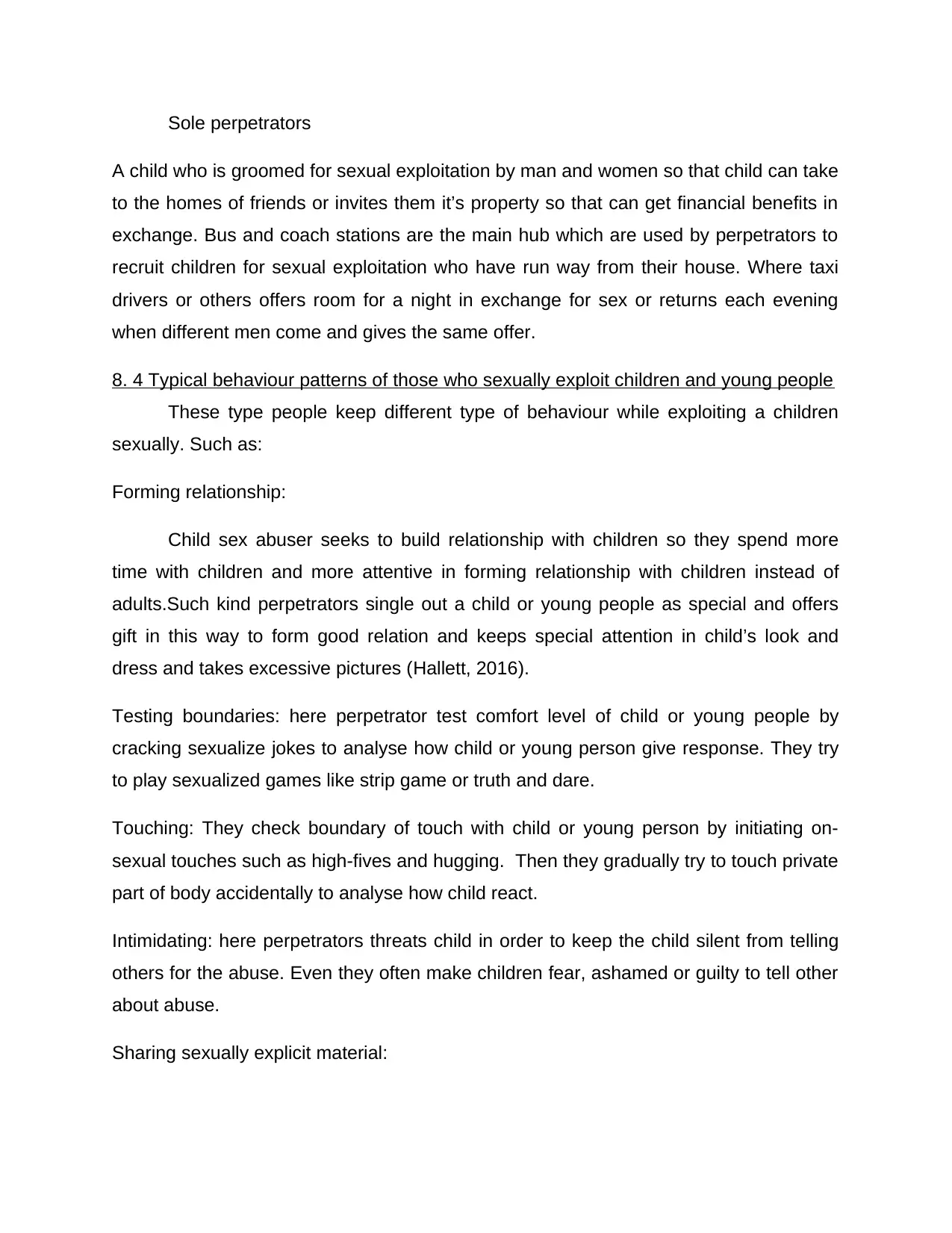
Sole perpetrators
A child who is groomed for sexual exploitation by man and women so that child can take
to the homes of friends or invites them it’s property so that can get financial benefits in
exchange. Bus and coach stations are the main hub which are used by perpetrators to
recruit children for sexual exploitation who have run way from their house. Where taxi
drivers or others offers room for a night in exchange for sex or returns each evening
when different men come and gives the same offer.
8. 4 Typical behaviour patterns of those who sexually exploit children and young people
These type people keep different type of behaviour while exploiting a children
sexually. Such as:
Forming relationship:
Child sex abuser seeks to build relationship with children so they spend more
time with children and more attentive in forming relationship with children instead of
adults.Such kind perpetrators single out a child or young people as special and offers
gift in this way to form good relation and keeps special attention in child’s look and
dress and takes excessive pictures (Hallett, 2016).
Testing boundaries: here perpetrator test comfort level of child or young people by
cracking sexualize jokes to analyse how child or young person give response. They try
to play sexualized games like strip game or truth and dare.
Touching: They check boundary of touch with child or young person by initiating on-
sexual touches such as high-fives and hugging. Then they gradually try to touch private
part of body accidentally to analyse how child react.
Intimidating: here perpetrators threats child in order to keep the child silent from telling
others for the abuse. Even they often make children fear, ashamed or guilty to tell other
about abuse.
Sharing sexually explicit material:
A child who is groomed for sexual exploitation by man and women so that child can take
to the homes of friends or invites them it’s property so that can get financial benefits in
exchange. Bus and coach stations are the main hub which are used by perpetrators to
recruit children for sexual exploitation who have run way from their house. Where taxi
drivers or others offers room for a night in exchange for sex or returns each evening
when different men come and gives the same offer.
8. 4 Typical behaviour patterns of those who sexually exploit children and young people
These type people keep different type of behaviour while exploiting a children
sexually. Such as:
Forming relationship:
Child sex abuser seeks to build relationship with children so they spend more
time with children and more attentive in forming relationship with children instead of
adults.Such kind perpetrators single out a child or young people as special and offers
gift in this way to form good relation and keeps special attention in child’s look and
dress and takes excessive pictures (Hallett, 2016).
Testing boundaries: here perpetrator test comfort level of child or young people by
cracking sexualize jokes to analyse how child or young person give response. They try
to play sexualized games like strip game or truth and dare.
Touching: They check boundary of touch with child or young person by initiating on-
sexual touches such as high-fives and hugging. Then they gradually try to touch private
part of body accidentally to analyse how child react.
Intimidating: here perpetrators threats child in order to keep the child silent from telling
others for the abuse. Even they often make children fear, ashamed or guilty to tell other
about abuse.
Sharing sexually explicit material:
⊘ This is a preview!⊘
Do you want full access?
Subscribe today to unlock all pages.

Trusted by 1+ million students worldwide
1 out of 20
Related Documents
Your All-in-One AI-Powered Toolkit for Academic Success.
+13062052269
info@desklib.com
Available 24*7 on WhatsApp / Email
![[object Object]](/_next/static/media/star-bottom.7253800d.svg)
Unlock your academic potential
Copyright © 2020–2025 A2Z Services. All Rights Reserved. Developed and managed by ZUCOL.





